Earth Art
You’re Gonna Need a Bigger Boat
I am not a well educated man when it comes to art. Give me a ten-dollar painting of a sailing ship from a yard sale or thrift store and I'll be perfectly happy with it. Every once in a while, though, I find something that makes me take notice—in this case, it's a fella named Michael Heizer.
Heizer is known as what we call a land or earth artist—someone who builds immense outdoor pieces designed around and for their specific locations. These pieces are left out in the open to age and erode naturally. (Kinda like me.) Many of the earliest pieces from the 1960s don't exist anymore. If nothing else, Heizer's pieces are particularly notable for their sheer size.
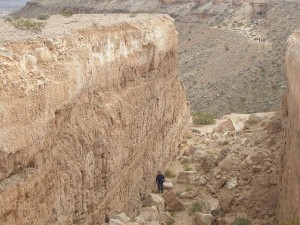 One of his best known pieces is a work called Double Negative, a pair of massive trenches cut into the edge of Mormon Mesa in Nevada. Each is 50 feet wide and 30 feet deep, and they have a combined length of 1,500 feet. The project involved moving 244,000 tons of rock.
One of his best known pieces is a work called Double Negative, a pair of massive trenches cut into the edge of Mormon Mesa in Nevada. Each is 50 feet wide and 30 feet deep, and they have a combined length of 1,500 feet. The project involved moving 244,000 tons of rock.
Another project, Levitated Mass, involved the suspension of a massive, 21-foot tall, 340-ton boulder above a concrete trench that you can walk through. Moving the boulder itself was a massive feat of engineering. It only had 60 miles to travel, as the bird flies, but in order to get there they took it on a tangled 106-mile route through 22 cities in order to find bridges strong enough and streets wide enough.
The colossal custom transport could only move at seven miles an hour, and so they needed 11 days to get there, traveling only at night. Along the way, they had to cut down trees, temporarily remove traffic lights, and tow cars. The whole route turned into a series of parties at the transport's daytime resting places.
(The event was so cool that our other Yard Ramp Guy has blogged about it.)
Heizer’s current project, in the works for 20 years now, is by far his most impressive. Not yet open to the public, it is an enormous, mile-long monolithic structure known only as City, with two smaller complexes nearby.
To give you a comparison, it's about the size of the National Mall in DC. It's located in the brand new Basin and Range National Monument. As soon as it opens to the public, you can bet I'll be visiting.
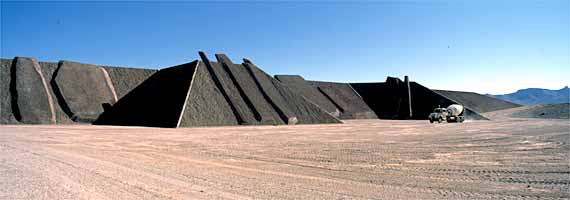
_________
Clf23 at English Wikipedia [GFDL, CC-BY-SA-3.0], via Wikimedia Commons
Now Dig This
One Way to Save on Airfare to China
Little kids try to dig to China all the time—regardless what’s actually on the other side of the world from them—and, well, they never get very far—because…
It’s dinnertime, or they bust a pipe and flood the basement, or mom comes out and tells them they can’t go because your passport is outdated and you’ll get tossed in jail and just wait till your father gets home, and when dad gets home he stares at them with a look that’ll keep‘em local for at least 12 more years.
And now that I’ve covered parenting tips and travails for the moment, what's the actual deepest hole ever dug?
 The Kola Superdeep Borehole, on the Kola Peninsula in northern Russia, reaches a depth of 40,230 feet. That’s more than seven and a half miles, far deeper than even the deepest point in any ocean. Started by the Soviet Union in 1970, it held the record for deepest borehole for decades.
The Kola Superdeep Borehole, on the Kola Peninsula in northern Russia, reaches a depth of 40,230 feet. That’s more than seven and a half miles, far deeper than even the deepest point in any ocean. Started by the Soviet Union in 1970, it held the record for deepest borehole for decades.
Though longer boreholes have since been drilled, largely for oil related purposes, the Kola Superdeep Borehole remains the deepest point on Earth. During its lifespan it contributed immensely to scientific understanding.
Work on the borehole shut down in 2005, due to lack of funding. Oh, and though the hole is still there, you can't fall into it: along with being sealed with a thick metal cap, it's too thin to accommodate a human.
Even though that project has ended, it's not the only one of its type.
The Chikyū, a Japanese scientific vessel, is a drilling ship designed to drill miles below the seafloor. While that won't likely ever reach the extreme depths of the Kola Superdeep Borehole, its data is much more scientifically interesting, through drilling into more seismically active regions where the crust is much thinner. The Chikyū might actually be able to reach the upper layers of the mantle.
(Fun fact: the boundary between the crust and the mantle is known as the Mohorovičić Discontinuity, though most geologists just call it the Moho.)
Why is it important to dig all of these holes? Well, apart from giving us a richer understanding of the Earth’s history, (which should be important enough on its own), we also gain more knowledge of continental drift, volcanism, rock formations, and mineral deposit locations.
That’s why we can thank all those who started digging those holes to China as kids, got interrupted by their meddling parents, and then returned to the dig after college. The way I see it: if the parents had only let their kids have at it, they would’ve saved a fortune on tuition.
Go Jump in a Lake
Or: Good Luck Getting There
The most interesting lake in the world is completely inaccessible.
Well, maybe not completely, but close enough for government work. Which, come to think of it, usually isn't that close.
Lake Vostok is located in Antarctica. Bit of a strange place for a lake, I know, but this gets even weirder. Its surface is 500 feet below sea level. Lake Vostok is believed to have species of bacteria that are present nowhere else on the planet. It's also the largest lake in Antarctica, at more than 160 miles long and 30 miles wide.
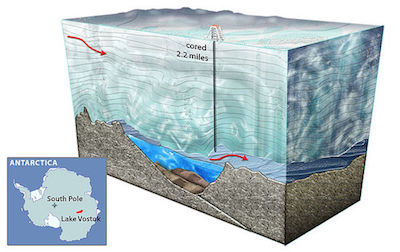 And just to make all this interesting, there's a magnetic anomaly in one end of the lake.
And just to make all this interesting, there's a magnetic anomaly in one end of the lake.
Vostok Station, the nearby research facility, recorded the coldest known temperature ever on our planet. The lake has a single island, which no one has ever set foot on. It's also in complete darkness, even during the part of the year when Antarctica gets sunlight. That, of course, is because it's buried under 13,000 feet of ice.
As in: Lake Vostok is buried under a two and a half mile-high glacier.
Clearly impossible, right? Normally, yes, but in this case, the massive weight and compression created by the glacier caused its lowest layer to heat up, melting the ice and forming Lake Vostok. There are more than 500 of these subglacial lakes in Antarctic.
The hunt for life in Lake Vostok has become a major point of interest. Any creepy-crawly thing there would likely have been sealed off for the lake’s entire 15 million-year lifespan. The warm, oxygen rich, and pitch black waters would have created an ecosystem unlike anything else on the planet.
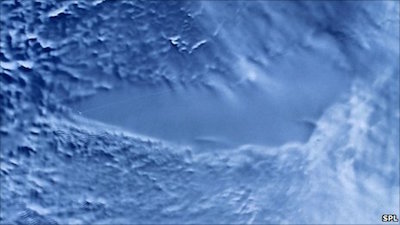 Unfortunately, there are concerns that the antifreeze used to maintain the boreholes through the glacier might contaminate the lake, so scientists are proceeding with extreme caution. While the overwhelming majority of species they have found could quite likely just be contaminants from the surface, they have found at least one previously unknown species that might very well have come from the lake itself.
Unfortunately, there are concerns that the antifreeze used to maintain the boreholes through the glacier might contaminate the lake, so scientists are proceeding with extreme caution. While the overwhelming majority of species they have found could quite likely just be contaminants from the surface, they have found at least one previously unknown species that might very well have come from the lake itself.
Mission to Mars? Sure. But Vacation in Vostok: now we’re talking…even though Maggie won’t hear of it.
The Dunning-Kruger Effect
The Strange Case of a Non-Invisible Man
There's a poker saying I've always been fond of: “If you sit in on a poker game and don't see a sucker, get up. You're the sucker.”
It's a great rule to live by, and not just in poker, but it’s pretty distressing how many people have obviously never heard it. We've all met them: people who completely fail to recognize their own incompetence, or think that they are geniuses despite overwhelming evidence to the contrary.
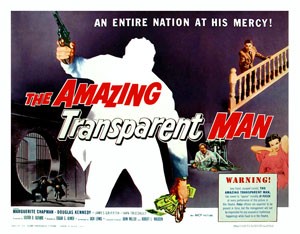 There's actually a name for this: The Dunning-Kruger effect. Though it was hardly a stunning revelation to anyone, David Dunning and Justin Kruger were the first ones to actually test for the phenomena. They were inspired by a news story about a man named McArthur Wheeler, who robbed a pair of banks after smearing lemon juice on his face. Apparently, he thought that lemon juice would make his face invisible to cameras, since lemon juice is usable as invisible ink.
There's actually a name for this: The Dunning-Kruger effect. Though it was hardly a stunning revelation to anyone, David Dunning and Justin Kruger were the first ones to actually test for the phenomena. They were inspired by a news story about a man named McArthur Wheeler, who robbed a pair of banks after smearing lemon juice on his face. Apparently, he thought that lemon juice would make his face invisible to cameras, since lemon juice is usable as invisible ink.
During their testing, Dunning and Kruger confirmed that unskilled people frequently overestimated their competence. One of the experiments performed involved giving various tests to subjects and then showing the subjects their scores. They then asked the subjects to estimate their rank. Those subjects who tested poorly consistently ranked themselves as much as 50 percentiles higher than their actual score.
Dunning and Kruger found an interesting flip side to the effect: highly skilled individuals tend to frequently underestimate their own competence—or, rather, they overestimated the competence of others—an effect that seems quite similar to Impostor Syndrome, which occurs when people are unable to really acknowledge their achievements.
I usually don't have a lot of interest in psychology; I tend to read much more about other social sciences, especially history and archeology. Why am I getting into it now?
Easy. I'm willing to put a lot of work into my insults, especially when they involve incompetent coworkers.





